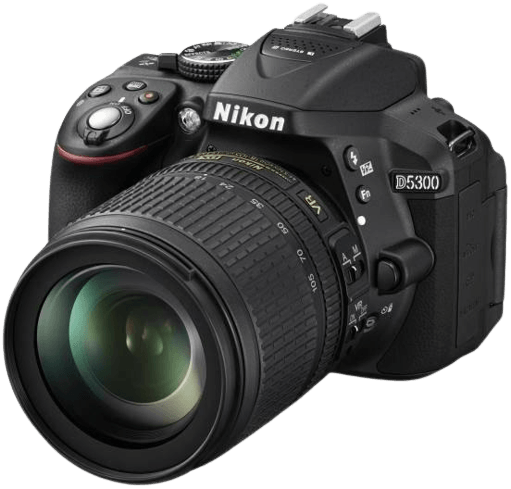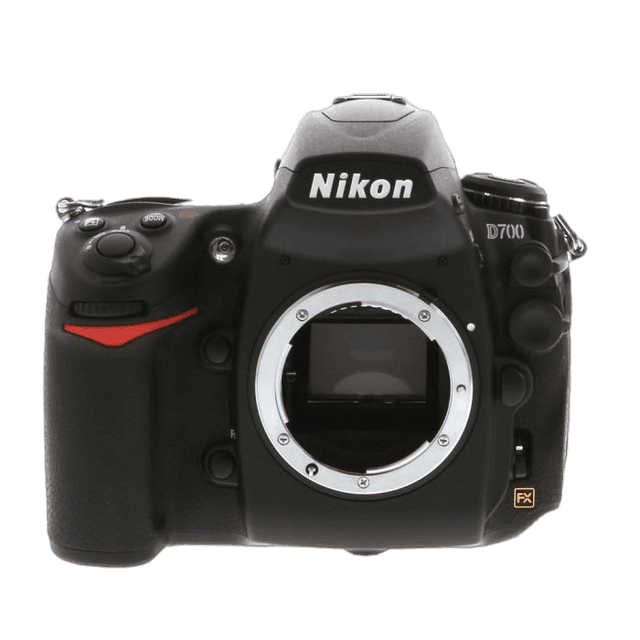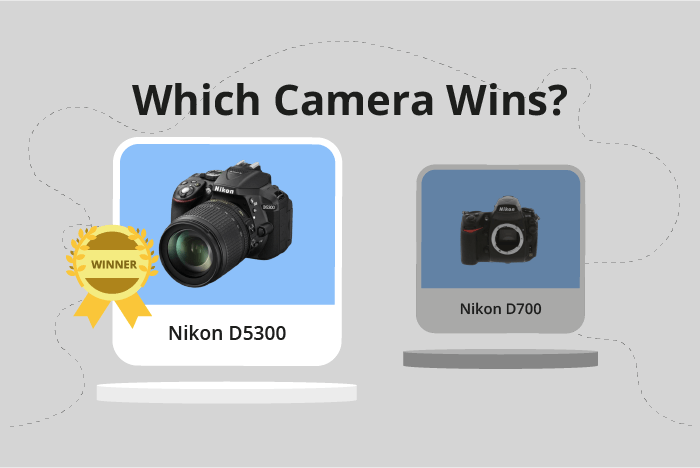Nikon D5300 vs D700 Comparison
Nikon D5300

Nikon D700

The Nikon D5300 emerges as the winner with a score of 57/100, while the Nikon D700 trails behind with a score of 53/100. Both cameras are DSLR models, released in 2013 and 2008 respectively. They share similarities in camera type and size, with the D5300 measuring 125 x 98 x 76mm and the D700 at 147 x 123 x 77mm.
The D5300 outperforms the D700 in terms of weight and price, weighing only 480g compared to the D700’s hefty 1074g. Additionally, the D5300’s launch price was $800, significantly more affordable than the D700’s $2699 price tag.
The D700, however, excels in its robust build and professional features that cater to more experienced photographers. Despite its higher price and weight, it offers quality and durability that some users may prefer.
Taking all factors into account, the Nikon D5300 provides a more lightweight and budget-friendly option, while the Nikon D700 caters to those seeking a more professional and durable camera.
Nikon D5300 vs D700 Overview and Optics
The Nikon D5300 outperforms the Nikon D700 in optics, scoring 65/100 compared to the D700’s 54/100. Both cameras share some common specifications, such as the CMOS sensor type, Nikon F lens mount, and the absence of image stabilization. However, there are key differences that set the D5300 ahead of the D700.
The D5300 has a higher resolution, boasting 24.2 megapixels compared to the D700’s 12.1 megapixels. This difference allows the D5300 to capture more detailed and high-quality images. Additionally, the D5300 has a more advanced processor, the Expeed 4, which improves image processing and overall performance. The D5300 also has a higher DXOMARK score for its sensor (83) compared to the D700’s score (80), indicating better image quality and low-light performance.
On the other hand, the D700 stands out with its faster shooting speed of 8 frames per second, compared to the D5300’s 5 frames per second. This makes the D700 more suitable for action and sports photography, where capturing rapid movements is crucial. Furthermore, the D700 features a full-frame sensor, which can produce better image quality and dynamic range than the D5300’s APS-C sensor, despite its lower resolution.
Taking these factors into account, the Nikon D5300 is the superior choice for those prioritizing high-resolution images and better low-light performance. However, the Nikon D700 may be more suitable for photographers who require a faster shooting speed and the benefits of a full-frame sensor.
Nikon D5300 vs D700 Video Performance
When comparing the video capabilities of the Nikon D5300 and the Nikon D700, it is important to note that the Nikon D700 does not have any video functionality. Therefore, this comparison will focus on the video capabilities of the Nikon D5300, as the D700 cannot be used for video recording.
The Nikon D5300 has a video score of 70 out of 100, which reflects its solid performance in this area. The camera is capable of recording Full HD video, with a maximum resolution of 1920 x 1080 pixels. This ensures that users can capture high-quality video footage with the D5300.
In addition to its resolution, the Nikon D5300 also has a maximum video frame rate of 60 frames per second (fps). This allows for smooth video playback, as well as the possibility of creating slow-motion effects in post-production. The camera also features built-in time-lapse functionality, enabling users to create stunning time-lapse videos without the need for additional equipment or software.
Taking into account the lack of video functionality in the Nikon D700, it is clear that the Nikon D5300 is the superior choice for users who require video capabilities in their camera. The D5300 offers Full HD video recording, a high frame rate, and built-in time-lapse functionality, making it a versatile and capable option for capturing video footage.
Nikon D5300 vs D700 Features and Benefits
The Nikon D700 comes out on top with a feature score of 54/100, while the Nikon D5300 follows closely with a score of 46/100. Both cameras share some common features, such as a 3-inch screen size, no touchscreen, WiFi capabilities, and no Bluetooth.
The D700 surpasses the D5300 in screen resolution, with 922000 dots compared to the D5300’s 1037000 dots. This higher resolution offers a sharper and clearer image when previewing shots or reviewing images. However, the D700 lacks a flip screen, which the D5300 has. The flip screen on the D5300 provides flexibility when shooting from different angles and can be useful for capturing creative shots.
The D5300 also has GPS, a feature the D700 lacks. This allows for geotagging of images, making it easier to track and organize photos by location. This can be especially useful for travel photography or documenting outdoor adventures.
The D700’s higher feature score does not necessarily mean it is a better camera, but it does indicate that it offers more features that may be useful to some photographers. The D5300, on the other hand, has its advantages, such as the flip screen and GPS. These features may be more valuable to specific users depending on their photography needs and preferences.
When considering these two cameras, it is essential to weigh the importance of the features they offer in relation to one’s photography requirements. The D700 may be the winner in terms of overall feature score, but the D5300 still has valuable features that may make it the right choice for some photographers.
Nikon D5300 vs D700 Storage and Battery
The Nikon D700 outperforms the Nikon D5300 in terms of storage and battery, scoring 43/100 compared to the D5300’s 29/100. Both cameras have one memory card slot and lack USB charging capabilities. However, there are differences in accepted memory cards and battery life that contribute to the D700’s higher score.
The D700 accepts Compact Flash (Type I) memory cards, while the D5300 is compatible with SD, SDHC, and SDXC cards. The D700’s battery life is notably longer, providing 1000 shots compared to the D5300’s 600 shots. The battery type for the D700 is the EN-EL3e, while the D5300 uses the EN-EL14a.
Despite the D5300’s lower score, its compatibility with SD, SDHC, and SDXC cards is an advantage as these cards are more common and affordable compared to the Compact Flash cards used by the D700. However, the D700’s superior battery life of 1000 shots is a significant advantage for photographers who require longer shooting sessions without needing to change batteries.
Considering the storage and battery aspects, the Nikon D700 is the better choice for those who value extended battery life. The Nikon D5300, on the other hand, offers more accessible and affordable memory card options, making it a suitable option for budget-conscious photographers.
Nikon D5300 vs D700 – Our Verdict
Are you still undecided about which camera is right for you? Have a look at these popular comparisons that feature the Nikon D5300 or the Nikon D700:

